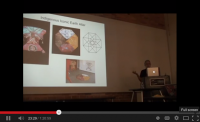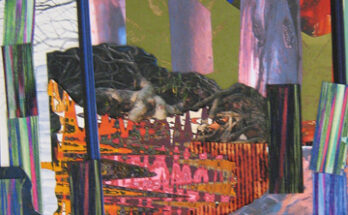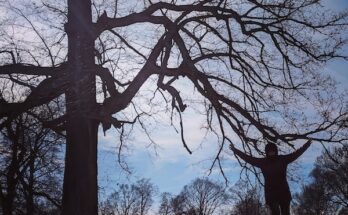Duke University- INDIGENEITY DECOLONIALITY@RT Artists Talk on YouTube
Check me out at minute 8:26
The INDIGENEITY DECOLONIALITY ARTISTS TALK took place on April 30, 2014 at Smith Warehouse, Durham NC
…”It’s called the Indigenous Iconic Earth Altar. You see the turtle again showing up. That’s the one that’s in the southern direction, which is the reddish/bluish part of the medicine wheel there. It’s obviously a shift in the media that I’m using because this is 3 dimensional and it’s fiber. It’s not paper collage and it’s not digital collage. The other ones were either actual handmade collage from my pre-computer days, or they were a similar technique but using pixels and cutting tools instead of scissors…. obviously this is something totally different, but I’m using and combining all the same themes really. I’m just kind of tying it all together and I’m adding traditional handwork like on the little extensions from the turtle piece where you see beadwork and feathers and what not. I’m combining that with digital tools, digital printing, all kinds of recycling…and by doing that I’m showing an interdependence relating to technology because I’m using modern high-tech stuff and I’m using the age old stuff as well. Not just the old handwork techniques, but also very old concepts, really powerful concepts, that revolve around a holistic understanding of the universe and the human relationship to all life forms, all levels and planes of knowing, all cycles, seasons, all the elements, it just keeps going on and on forever. You know the medicine wheel is a philosophy that basically talks about how we’re part of everything and everything is part of us. And it’s inherently an environmental statement because by thinking that way it automatically makes you look at the whole picture and makes you realize, yeah, you’re related to that spider over there, maybe you should consider not stepping on it before you step on it, or maybe you want to kill it consciously, but at least you would be thinking that way. Then there’s another aspect of this that kind of leads into science a little bit. And that is that if you look closely at the medicine wheel, its got certain patterns stitched into it. And that stitched geometry there is known as a tesseract or a hyper cube. It’s a configuration that represents the fourth dimension, which really is a representation of the spirit plane. And it also is connected to space-time. And that’s a quantum physics term…so what I’m doing here is I’m crossing cultures and I’m trying to show commonality. So I’ve got the original tesseract design so you can kind of see it clearly in there…I’ve opened up the center of my wheel to show that Native American duality concept of complementary duality. So it kind of obliterates the clean geometry in there…. But that’s really important for me because I think that a lot of cultures actually end up talking about similar things but they just don’t realize it, and so we think we have to argue it down and everything, but I really think that space-time, unity theory, that’s the same as the medicine wheel philosophy of “We Are All Related.” In my mind that’s got to be the same so that’s why I put it together like that. Because I could …and I decided I think it’s the same concept. And I think we need this non-hierarchical way/outlook in order to collaborate and free our minds, free the colonizer’s mind, free the colonized mindset, so we can embrace what we have to do in terms of creating a sustainable future. Because we’re kind of running out of time, and that’s my little soapbox statement, but that’s what my work is about…especially this piece. Like I said, this piece is the culmination of all my other stuff. This is where I really was like, ok, yeah, I’m Indigenous, but I’m also English, and I’m also Black and I want to bring something together that’s really universal, but I also want to say we need the indigenous philosophy. Everybody needs this Indigenous philosophy to get to where we need to go now.”




